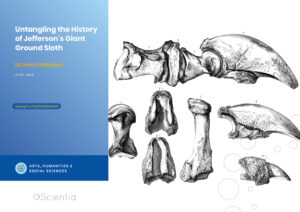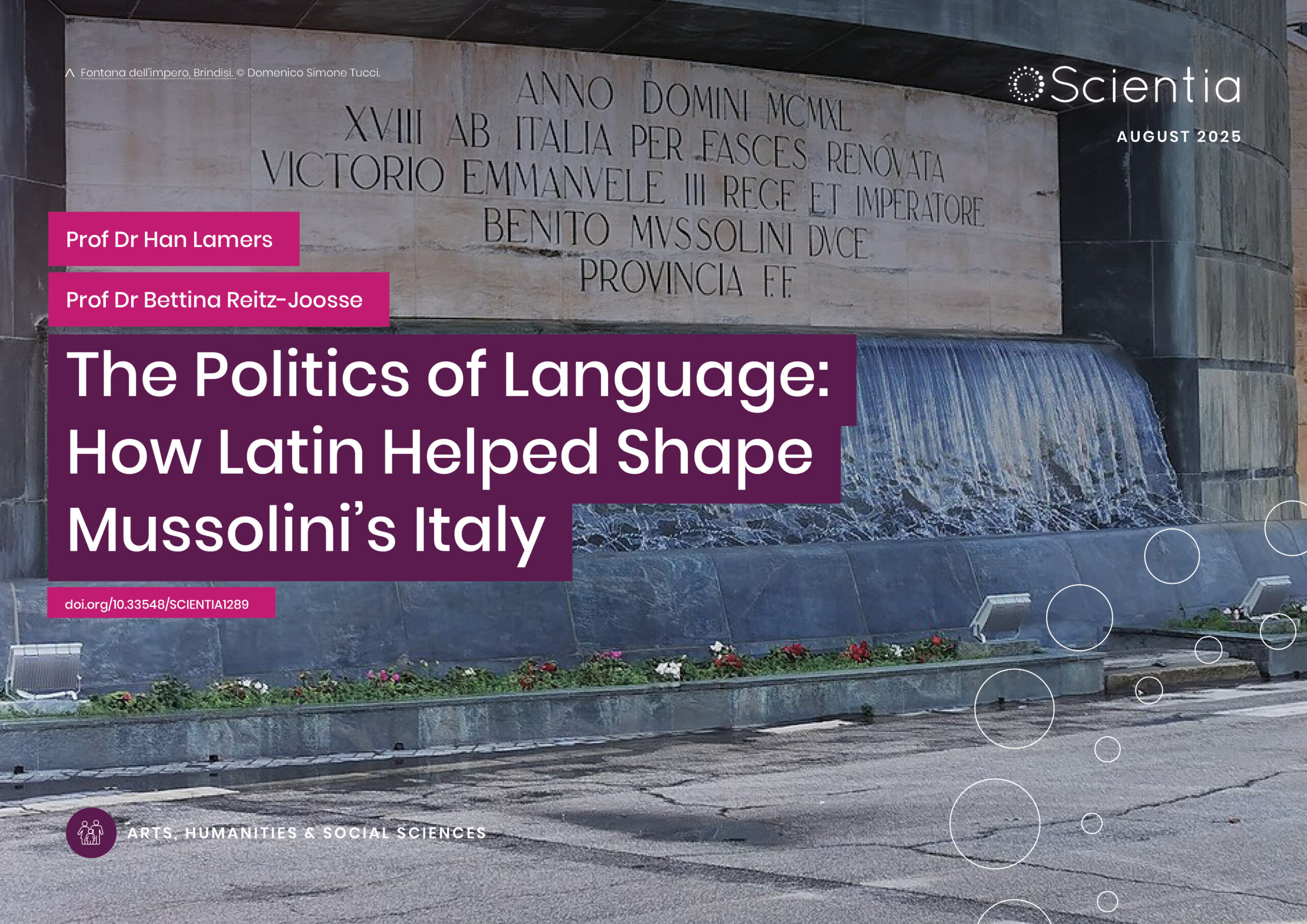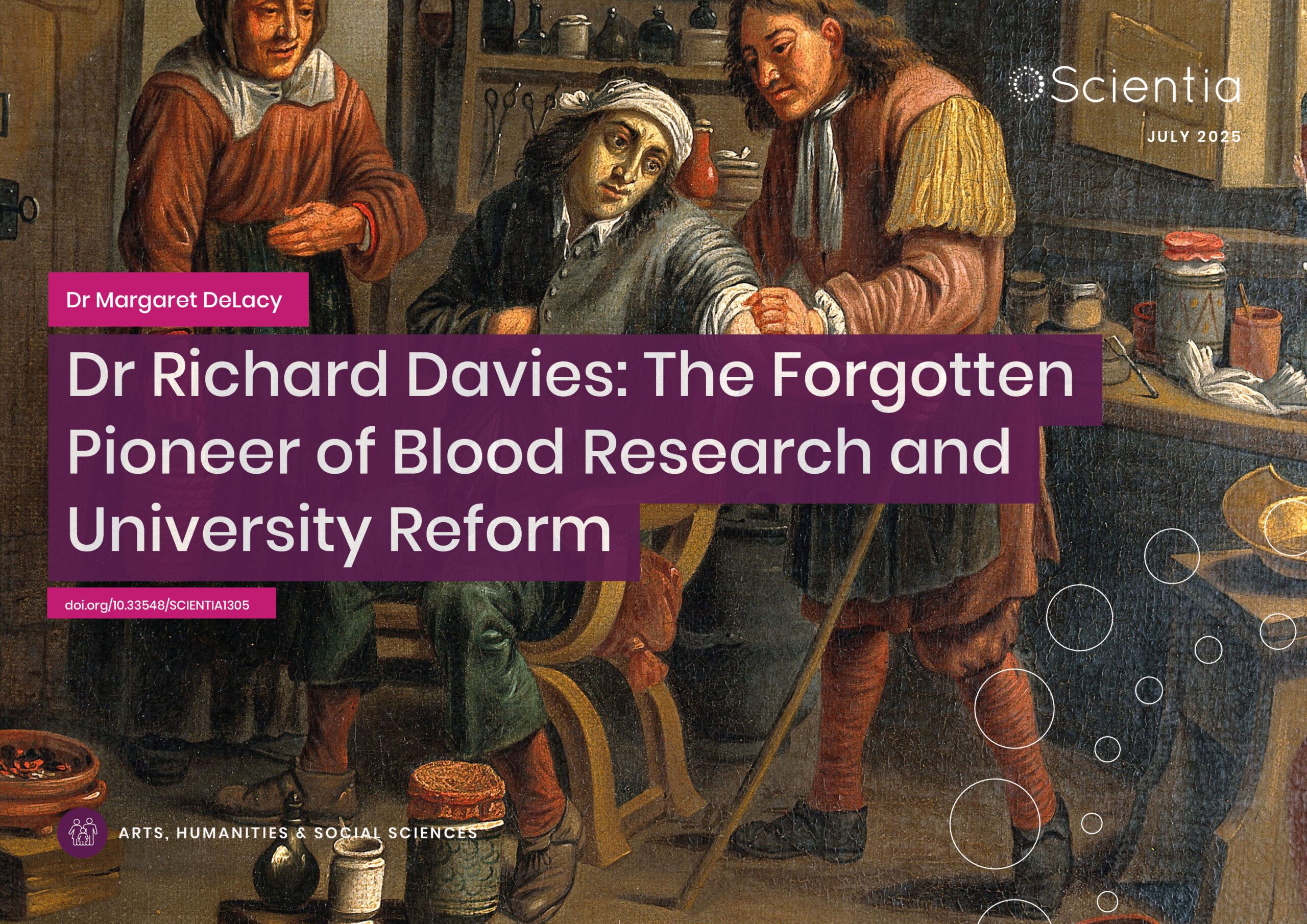Dr Loren Babcock | Untangling the History of Jefferson’s Giant Ground Sloth
In the spring of 1796, workers mining saltpetre in a western Virginia cave unearthed several unusual bones. This would launch the scientific study of extinct animals in North America and connect one of America’s founding fathers to the early development of palaeontology. Some of these mysterious bones eventually made their way to future US President Thomas Jefferson at his Monticello estate. Dr Loren Babcock from The Ohio State University’s School of Earth Sciences has conducted an extensive review of the complex naming history of this iconic extinct animal. His research untangles over 200 years of inconsistent scientific terminology and establishes the definitive nomenclatural history of what would become known as Megalonyx jeffersonii.
The Birth of American Palaeontology
Thomas Jefferson carefully studied the creature’s remains, which included bones from the left paw, arm bones, and part of a leg bone. Based on the impressive curved claws, he initially thought they belonged to a massive lion-like predator. He prepared a detailed paper on his findings, but just days before he was to deliver it, he encountered a paper that was published the previous year by the renowned French anatomist Georges Cuvier on a giant ground sloth from Argentina named Megatherium. Jefferson realised that the claws from western Virginia closely resembled the claws of Megatherium, and quickly revised his interpretation. His paper on a giant ground sloth was delivered orally to the American Philosophical Society in March 1797. The paper was published in 1799, and Jefferson proposed the name Megalonyx (meaning ‘Great Claw’ in Greek) for the enormous clawed beast.
Colleagues with access to comparative anatomical specimens would soon concur with Jefferson’s revised interpretation. Dr Caspar Wistar published a more detailed analysis alongside Jefferson’s paper in the same volume, including careful illustrations of the bones. Wistar described the similarities between the remains and the skeletons of living tree sloths. This interpretation would soon be confirmed by Georges Cuvier, who received plaster casts of the bones for study.
The original bones that Jefferson studied are now at the Academy of Natural Sciences at Drexel University, Philadelphia. They include several bones from the left paw, including metacarpals, various phalanges (finger bones), and the impressive claws that gave the animal its name, along with a radius and ulna from the forearm. These specimens serve as the holotype (the standard reference material for the species).
The Story of a Name
The species-level name has an equally complex history. In 1822, the French naturalist Anselme Gaëtan Desmarest formally named the species Megatherium jeffersonii in honour of Jefferson, placing it in the same genus of giant ground sloth that had been found in South America. Three years later, Richard Harlan recognised that it properly belonged in Jefferson’s genus Megalonyx, creating the combination Megalonyx jeffersonii that we use today.
Dr Loren Babcock’s research resolves several long-standing controversies about the proper scientific name for Jefferson’s ground sloth. The first involves the authorship and date of the genus name Megalonyx. Although some researchers have attributed this name to later authors, particularly Richard Harlan in 1825, Babcock demonstrates that Jefferson’s 1799 publication meets all the technical requirements for establishing a valid scientific name.
The publication included several critical elements: it was properly published using ink on paper in a scientific journal, the name was explicitly stated to be new, and it was accompanied by both an etymology explaining the meaning of the name and a brief diagnosis identifying the distinguishing characteristics of the animal. The name was also accompanied by a detailed description of the available skeletal elements and their measurements.
Moreover, Jefferson provided a comparative analysis with known animals, specifically the African lion, even though this comparison was incorrect. He also clearly identified the discovery’s geographic location and geological context. These elements together satisfy all the requirements for establishing a valid scientific name under the rules of modern zoological nomenclature.
The Evolution of Understanding
The discovery came at a pivotal time in the development of scientific thought about extinct animals. When Jefferson first described these bones, the very concept of extinction was still controversial and poorly understood. His initial interpretation of the remains as belonging to a predatory cat reflected both the limited comparative material available to American naturalists at the time and a common misconception that species could ever truly become extinct.
The eventual correct identification of Megalonyx as a giant ground sloth helped contribute to the growing acceptance of extinction as a natural phenomenon. It also highlighted the importance of comparative anatomy in paleontological studies, as it was only through comparison with living sloths that the true nature of the animal could be fully understood.
A Legacy of Discovery
Since Jefferson’s initial description, Megalonyx has proven to be one of the most widespread large mammals of Ice Age North America. Fossils have now been found at over 180 locations across the continent, revealing that these giant ground sloths lived from coast to coast during the Pleistocene Epoch. This extensive fossil record has allowed palaeontologists to build a much more complete picture of the animal than Jefferson could have imagined from his few initial bones.
Modern reconstructions show that Megalonyx was a massive herbivore standing about 2.1 metres tall. Rather than the fearsome predator Jefferson initially imagined, it was a relatively slow-moving plant-eater, using its large claws primarily for pulling down branches and defending itself against actual predators.

Credit: Loren E Babcock
Spelling and Technical Matters
Dr Babcock’s research also resolves several technical issues regarding the correct spelling of both the genus and species names. The genus should be spelled Megalonyx, with an -onyx ending derived from the Greek root, rather than Megalonix as it sometimes appears in literature. Similarly, the species name should end in -ii (jeffersonii) rather than the single -i (jeffersoni) that appears in some publications.
These spelling variations might seem minor, but maintaining consistent scientific names is crucial for both clear communication among researchers and stable zoological nomenclature. The confusion around these spellings reflects the lack of standardised rules for scientific naming in the late 18th and early 19th century when these names were first proposed.
The Broader Context
Beyond clarifying nomenclatural issues, Dr Babcock’s research highlights the historical significance of Jefferson’s work in the development of American science. The description of Megalonyx represents one of the earliest contributions to what would eventually become the science of palaeontology, appearing decades before that term was even coined in the 1820s.
The research also illuminates how scientific naming practices have evolved. In Jefferson’s time, there were no formal rules governing how new genera or species should be named and described. Today, the International Code of Zoological Nomenclature provides detailed guidelines that help prevent the kind of confusion that has surrounded Megalonyx for more than two centuries.
The Historical Legacy
The story of Megalonyx exemplifies both the birth of American palaeontology and the evolution of scientific practice. From Jefferson’s initial misidentification to our modern understanding of this impressive Ice Age herbivore, it demonstrates how scientific knowledge advances through careful observation, reasoned debate, and systematic documentation.
The cave where the original bones were found, now known as Haynes Cave, is currently located in Monroe County, West Virginia, following political reorganisation of the region. Historical research has also revealed that the cave’s owner in 1796, identified in Jefferson’s paper as ‘Frederick Cromer’, was actually Frederick Gromer, an example of how even minor historical details continue to be refined through careful scholarship.
Looking Forward
As studies of Megalonyx continue, a clear understanding of its nomenclatural history creates a solid foundation for future research. Recent studies have revealed new aspects of these animals’ lives, including evidence that some cave sites may have served as maternity dens. Multiple individuals have been found at some localities, suggesting complex social behaviours that we are only beginning to understand. This remarkable creature, first brought to scientific attention by one of America’s founding fathers, continues to help us understand the remarkable megafauna that once roamed North America. More than two centuries after its initial description, it remains a testament to the power of scientific inquiry and the importance of careful documentation in advancing our understanding of the natural world.
SHARE
DOWNLOAD E-BOOK
REFERENCE
https://doi.org/10.33548/SCIENTIA1248
MEET THE RESEARCHER

Dr Loren E Babcock
School of Earth Sciences, The Ohio State University, OH, USA
Dr Loren Babcock is a Professor and Director of the Orton Geological Museum at The Ohio State University. His research spans palaeontology, stratigraphy, and museum studies, with particular expertise in Palaeozoic fossils and Cambrian geology. As Chair of the International Subcommission on Cambrian Stratigraphy (2012–2020), he led global efforts to define and ratify stages and series of the Cambrian System. Dr Babcock has pioneered educational initiatives, including the Natural History Museum Curation Certificate Program and STEM Enrichment Initiative for underrepresented students. His recent work includes arthropod palaeobiology and fossilization history, vertebrate palaeontology, and the Megalonyx Project, which bridges science education, technology, and human affairs through restudy of a landmark fossil discovery. In addition to museum leadership, he contributes significantly to public engagement through website management and educational program development.
CONTACT
E: babcock.5@osu.edu
W: https://ortonmuseum.osu.edu/people/babcock.5
https://orcid.org/0000-0002-9324-9176
https://www.researchgate.net/profile/Babcock-Loren-2
https://www.linkedin.com/in/loren-babcock-75a5b220/
KEY COLLABORATORS
Professor Per Ahlberg, Department of Geology (Emeritus), Lund University, Lund, Sweden
Dr H Gregory McDonald, US National Park Service (retired), Ft. Collins, Colorado, USA
Professor Shanchi Peng, State Key Laboratory of Palaeobiology and Stratigraphy, Nanjing Institute of Geology and Palaeontology, Chinese Academy of Sciences, Nanjing, China
Professor Richard A Robison, Department of Geology (Emeritus), University of Kansas, Lawrence, Kansas, USA
Professor Maoyan Zhu, State Key Laboratory of Palaeobiology and Stratigraphy, Nanjing Institute of Geology and Palaeontology, Chinese Academy of Sciences, Nanjing, China
FUNDING
Battelle Engineering, Technology and Human Affairs (BETHA) Endowment
US National Science Foundation
National Geographic Society
Stiftelsen Längmanska kulturfonden
FURTHER READING
LE Babcock, Nomenclatural history of Megalonyx Jefferson, 1799 (Mammalia, Xenarthra, Pilosa, Megalonychidae), ZooKeys, 2024, 1195, 297–308. DOI: https://doi.org/10.3897/zookeys.1195.117999
LE Babcock, Some vertebrate types (Chondrichthyes, Actinopterygii, Sarcopterygii, and Tetrapoda) from two Paleozoic Lagerstätten of Ohio, U.S.A., Journal of Vertebrate Paleontology, 2024, 44, e2308621. DOI: https://doi.org/10.1080/02724634.2024.2308621
LE Babcock, SC Peng, CE Brett, et al., Global climate, sea level cycles, and biotic events in the Cambrian Period, Palaeoworld, 2015, 24(1–2), 5–15. DOI: https://doi.org/10.1016/j.palwor.2015.03.005


REPUBLISH OUR ARTICLES
We encourage all formats of sharing and republishing of our articles. Whether you want to host on your website, publication or blog, we welcome this. Find out more
Creative Commons Licence (CC BY 4.0)
This work is licensed under a Creative Commons Attribution 4.0 International License. 
What does this mean?
Share: You can copy and redistribute the material in any medium or format
Adapt: You can change, and build upon the material for any purpose, even commercially.
Credit: You must give appropriate credit, provide a link to the license, and indicate if changes were made.
SUBSCRIBE NOW
Follow Us
MORE ARTICLES YOU MAY LIKE
Prof Han Lamers – Prof Dr Bettina Reitz-Joosse | The Politics of Language: How Latin Helped Shape Mussolini’s Italy
When wandering through Italian cities today, visitors will encounter Latin inscriptions on all manner of buildings and monuments. While many date back to ancient Rome, the Middle Ages, or the Renaissance, others were created during Benito Mussolini’s Fascist regime (1922–1943). These Latin texts weren’t merely decorative — they were deliberately crafted political tools that helped forge connections between Fascist Italy and ancient Rome, embedding the regime’s ideology into the very fabric of Italian society.
Ongoing research by Professor Han Lamers (University of Oslo) and Professor Bettina Reitz-Joosse (University of Groningen) reveals how Fascist Italy weaponized ancient Rome’s language to legitimise its power and connect Mussolini’s regime to Italy’s imperial past. Their projects involve collaboration with an international team of mostly junior researchers based in Norway, the Netherlands, Austria, and Italy.
Dr JoLee Sasakamoose – Dr Mamata Pandey | Empowering Indigenous Health: The Indigenous Wellness Research Collaborative in Saskatchewan
The Indigenous Wellness Research Collaborative is a transformative alliance dedicated to advancing health systems and service delivery for Indigenous communities across Saskatchewan. Founded a decade ago and co-led by Dr Mamata Pandey, a research scientist at the Saskatchewan Health Authority, and Dr JoLee Sasakamoose (M’Chigeeng First Nation), Canadian Institute of Health Research Chair in Indigenous Wellness and Health Equity at the University of Regina, their team’s work is rooted in a commitment to Indigenous leadership and community-defined wellness goals. Guided by the Cultural Responsiveness Framework, the Collaborative prioritises creating ethical spaces that serve as a middle ground for respect, reciprocity, and authentic partnerships. The team employs a strengths-based approach to health research, centering Indigenous methodologies that respect the interconnectedness of spiritual, mental, emotional, and physical well-being.
Dr Richard Davies: The Forgotten Pioneer of Blood Research and University Reform
Dr Richard Davies was an 18th century physician whose bold ideas spanned medical science, public health, and university reform. Yet, his name is little known today. From discovering features of inflammation in blood, to proposing a national system to control cattle plague, his work prefigured modern approaches to medicine and governance. Nevertheless, his calls for change often fell on deaf ears, and his contributions were overlooked or appropriated by others. Dr Margaret DeLacy revisited Dr Davies’ remarkable career, exploring how a forgotten doctor helped shape the future of medical thinking.
How Food Environments Shape Our Eating Habits
How we eat dramatically impacts our health, yet millions of Americans live in ‘food deserts’ – areas with limited access to fresh, nutritious food. Recent research reveals that solving this crisis requires looking beyond just physical access to food to understand how our entire community environment shapes our dietary choices. Through a series of pioneering studies, Dr Terrence Thomas and colleagues at North Carolina A&T State University have been investigating how different aspects of our food environment influence what we put on our plates. Their findings suggest that creating lasting change requires reimagining how communities engage with food at every level.





